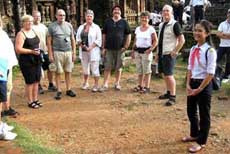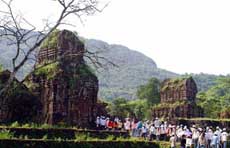People may be amazed when seeing a little girl in a red neckerchief, Phung Thi Trinh, leading a group of foreign tourists through the ruins of the Cham religious site of My Son, a World Cultural Heritage Site in Duy Xuyen District, in the central province of Quang Nam.
 |
| Font of knowledge: Phung Thi Trinh (right) leads foreign tourists during a visit to the My Son relics. |
The 15-year-old student is confident, professional and dynamic when greeting groups of tourists. "I'm delighted to lead you on your visit to My Son. I would like to introduce the value and unique character of this world cultural heritage site," the young tour guide says.
This year, tourists from both home and abroad have visited My Son to attend the festivities to mark a decade of UNESCO recognition of the site as a world cultural heritage.
My Son is within a valley in Quang Nam, around 69km southwest of Da Nang city. From the 4th to 15th centuries, it was an imperial city built by King Bhadravarman, and the centre for spirituality and worship during the reign of the Kingdom of Champa. This is graphically illustrated by the remains of a series of impressive tower-temples located at My Son.
Although time and the war have destroyed most of the towers, the remaining sculptural and architectural remnants still reflect the style and history of the art of the Cham people. Their masterpieces mark a glorious period for the architecture and culture of the Cham, and the whole of Southeast Asia.
Exemplifying the height of Cham architectural achievement, the My Son sanctuary is a large complex of monuments originally consisting of more than 70 structures in a variety of different styles, only 25 of the structures remain today. They include temples and towers that connect to each other with complicated red brick designs. The main component of the Cham architectural design is the tower, built to reflect the divinity of the king. Bricks are main material used in the constructions.
However, scientists have yet to discover the secret of how the towers were constructed, or how the bricks were fused together or used in construction by the Cham.
According to records on stone stele found on the site, the prime foundation of the ancient My Son architectural complex worshipped Shiva Bhadresvera. In the late 16th century, a big fire destroyed the temple. Step by step, historical mysteries have been unveiled by scientists.
Significance
 |
| Time trekking: Although time and war have left most of the towers destroyed, the remaining sculptural and architectural remnants still reflect the art and history of the Cham people and attract thousands of tourists each day. |
The other foremost absorbing element of My Son, besides its significance as a religious site, is its unique Cham-style architecture, which was greatly affected by Indian design. Each historical period has its own identity, so that each temple worshipping a god or a king of a different period has its own architectural style.
All of the Cham towers were built on a quadrate foundations and each comprises three parts: a solid tower base, representing the world of human beings; the mysterious and sacred tower body, representing the world of spirits; and the tower top built in the shape of a man offering flowers and fruits or of trees, birds and animals representing things that are close to both the spiritual world and human beings.
Although few remnants remain, those that still exist display the typical sculptural values of Cham culture. They are also vivid proof of a nationality living within Viet Nam today boasting a rich cultural tradition.
When UNESCO held a heritage conference dedicated to raising popular awareness of the site's value, the Duy Xuyen District education department decided to open school trips from 2004, according to Vo Thien Tinh, deputy chief of the district's Education and Training Office.
The office worked together with My Son heritage management board to compile documents to promote study of the site, while campaigning for its preservation and upgrading. The documents introduce the history, development process, decline and restoring of the My Son Site. The value of the My Son site is incorporated into the history and geography lessons of students in the region, said Vo Quang Luc, principal of Tran Cao Van School.
Until now, Trinh is not the only student acting as a tour guide in the province. Her Ngo Quyen Secondary School, is one among schools in the region training students to act as local tour guides. Dozens of Ngo Quyen students can introduce sites in English, while other students can work as tour guides for domestic visitors.
"They work as professional tour guides," says tourist Nguyen Trung Hieu from Ha Noi. "Their lively introductions helped us get a better understanding of the significance of the site."
The first time standing Trinh stood in front of a group of foreign tourists made nervous, but now she is used to the tours. Trinh and her friends now are happy to play their part in attracting tourists to the province and its special sites of cultural value.